Apple HomeKit Security takes home protection to the next level. Home safety is no longer just about locks and keys, and with smart technology becoming part of everyday life, securing your home has never been easier or more advanced. The challenge, however, is that not every smart CCTV system integrates smoothly with Mac or other Apple devices. That’s where Apple HomeKit Security stands out, offering a seamless, privacy-first solution that connects effortlessly across your entire Apple ecosystem. Apple’s platform is known for its tight integration, polished design, and strong focus on privacy. When you bring that philosophy into home safety, you get a system that is both reliable and user-friendly. If you’re planning to expand your setup, take a look at How to Connect Security Camera to Phone to make the most of your smart surveillance experience. Whether you’re a homeowner looking to protect your family or a renter wanting to monitor deliveries, Apple HomeKit offers a flexible way to do it without unnecessary hassle.
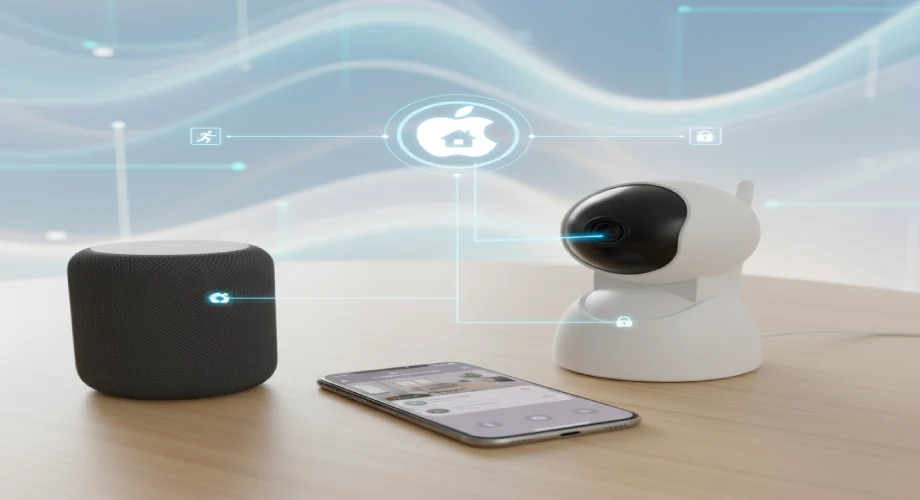
What Is Apple HomeKit Security?
At its core, the Apple smart home interface is Mac’s smart home platform. It allows you to control a wide range of devices including lights, locks, thermostats, cameras, and sensors, all from the Home app or with simple Siri voice commands. When it comes to safety, Mac adds an extra layer called HomeKit Secure Video (HSV), and this is where things get interesting. HSV processes and encrypts your security camera footage locally on a trusted Mac device. Only after that step is the footage stored in your iCloud+ account, where it remains encrypted end-to-end. In simple terms, no one can access your recordings.
Here’s why that matters:
- Privacy-first design: Unlike some competitors, it doesn’t sell your data or use camera footage to target ads.
- Integration: Cameras and sensors work hand in hand with your iPhone, iPad, and Siri, making your setup seamless.
- Control: You can view live streams, get motion alerts, and even set up automation — like turning on the porch light when your camera detects movement.
Think of it as hiring a safety guard who never gossips, never slacks off, and definitely won’t sell your info to the highest bidder.
Why HomeKit Security Stands Out
When it comes to smart safety, you’ve got plenty of choices — Google Nest, Amazon Ring, and a dozen other platforms fighting for your attention. So why lean toward Apple smart home interface? A few reasons stand out:
- Privacy is baked in – Apple doesn’t just talk about privacy; it’s in their DNA. With HomeKit Secure Video, your footage is processed locally first and encrypted before heading to iCloud. That means strangers can’t spy on your clips.
- Smooth ecosystem integration – If you already own an iPhone, iPad, Mac creator TV, or HomePod, adding safety devices is effortless. Everything lives inside the Mac Home app, so you’re not bouncing between multiple apps just to check your front door.
- Siri voice control – Sometimes you don’t want to open an app. A simple “Hey Siri, show me the front door” brings up your live camera feed instantly.
- Automation potential – Cameras can work with lights, locks, and sensors. Example: when motion is detected at night, your porch light can flip on automatically.
One trade-off? The selection of HomeKit-compatible devices isn’t as wide as what you’ll find with Google or Amazon. But the ones that do work are high-quality and tightly integrated.
👉 Related read: Curious if these devices need Wi-Fi to run smoothly? Check out our breakdown on Do CCTV cameras need Wi-Fi for the full scoop.
Best Security Cameras for Apple HomeKit
Now for the fun part — picking the right cameras. Digital home assistant security shines brightest when paired with well-built devices that work natively with Apple’s platform. Below are some of the top choices, each with pros, cons, and the type of user they suit best.
Aqara Camera Hub G3
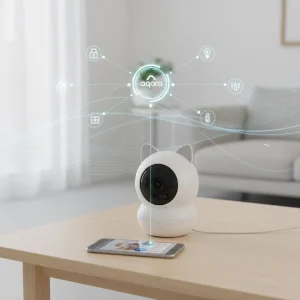 Why it’s great: This little powerhouse doubles as both a camera and an astute home hub. Perfect if you’re just starting out with a digital home assistant.
Why it’s great: This little powerhouse doubles as both a camera and an astute home hub. Perfect if you’re just starting out with a digital home assistant.- Pros: Facial recognition, pan/tilt design, works as a Zigbee hub.
- Cons: Better indoors than outdoors; the design isn’t exactly subtle.
- Best for: Apartment dwellers or anyone who wants one device to do double duty.
Arlo Essential Video Doorbell (with hub)
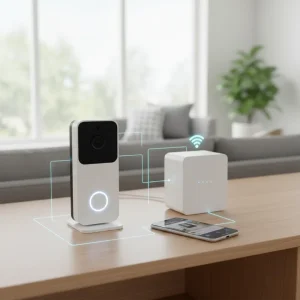 Why it’s great: A front-door favorite, this doorbell cam delivers sharp video and reliable notifications.
Why it’s great: A front-door favorite, this doorbell cam delivers sharp video and reliable notifications.- Pros: Wide field of view, clear video, supports two-way audio.
- Cons: Requires the Arlo hub for digital home assistant integration, which means extra cost.
- Best for: Homeowners who want a clean, Apple-friendly doorbell camera without headaches.
Eufy Cam E220
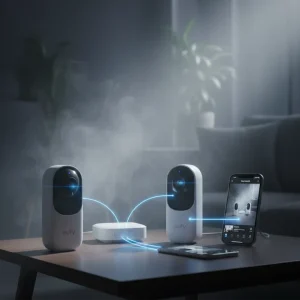 Why it’s great: Flexible enough for indoors and outdoors, with solid battery life.
Why it’s great: Flexible enough for indoors and outdoors, with solid battery life.- Pros: Local storage option, no mandatory subscription, weather-resistant.
- Cons: Some advanced features are app-specific and won’t fully show in digital home assistant.
- Best for: Families who want safety without monthly subscription fees.
Eve Outdoor Cam
 Why it’s great: A premium option designed specifically for Apple digital home assistant, with a sleek look.
Why it’s great: A premium option designed specifically for Apple digital home assistant, with a sleek look.- Pros: Crisp video, built-in floodlight, native smart device management system
integration. - Cons: On the pricier side, installation requires wiring.
- Best for: Homeowners who want a permanent, polished outdoor safety solution.
Honorable mentions: Ecobee Smart Camera, Aqara Smart Video Doorbell G4. Both add more variety for Mac users who want specific features.
Beyond Cameras: Other Apple-Compatible Security Devices
While cameras grab the spotlight, they’re only one part of a complete Apple smart home protection setup. Other devices can make your home safer when paired inside the platform.
- Motion sensors – Detect movement and trigger automations. Example: hallway lights turning on when you walk at night.
- Door/window sensors – Simple but effective. You’ll know instantly if someone opens an entry point when they shouldn’t.
- Smart locks – Unlock doors with your iPhone or Mac Watch. Great for letting in family, trusted guests, or service people without handing out spare keys.
- HomePod mini as a hub – Doubles as a smart speaker and the control center that keeps your smart device management system running smoothly, even when you’re away.
One last thing to note: the Matter standard is slowly expanding compatibility across brands. That means your Apple setup might work with more third-party devices in the near future. Translation? Fewer headaches, more choices.
Choosing the Right Setup
Selecting the most effective configuration for Apple smart home protection requires consideration of several interrelated factors:
- Camera quality: Resolution and field of view determine the level of detail captured. A wider lens ensures coverage of large entryways, while higher resolution is essential for identifying fine details such as license plates or facial features.
- Design and placement: Indoor and outdoor environments present different requirements. Indoor cameras may emphasize discretion and mobility, while outdoor models require weather resistance and robust mounting solutions.
- Power source: Wired devices offer uninterrupted operation but necessitate installation and proximity to power outlets. Wireless models allow greater flexibility in placement but rely on battery maintenance and Wi-Fi stability.
- Storage considerations: iOS network Secure Video integrates directly with iCloud+. While cost-efficient, it requires an ongoing subscription. Some devices provide local storage options for users who prefer reduced reliance on cloud services.
Ultimately, the correct setup depends on property type, household size, and the balance between convenience, cost, and permanence desired by the user.
Setting Up Apple HomeKit Security: Step by Step
The process of establishing a smart device ecosystem is straightforward, though methodical execution ensures optimal functionality:
- Device installation – Physically mount or position the camera or sensor as recommended by the manufacturer. For wired products, confirm compatibility with household electrical systems.
- Brand app configuration – Initial setup typically occurs within the device manufacturer’s native app. This step is necessary to activate the device, connect it to Wi-Fi, and apply firmware updates.
- Integration with Apple Home – Open the iOS ecosystem app, select Add Accessory, and scan the provided HomeKit code. The device will then appear within the centralized Home dashboard.
- Automation setup – Establish customized routines, such as linking motion detection to automated lighting or sending notifications when doors or windows are opened.
- Testing and calibration – Conduct a trial run of notifications, video streams, and Siri commands to ensure accuracy and responsiveness.
Following this structured approach reduces the likelihood of compatibility issues and ensures seamless integration within the broader iOS ecosystem.
Tips for Maximizing HomeKit Security
While installation is a critical step, optimization ensures the system delivers ongoing value. Consider the following best practices:
- Strategic placement: Position cameras at key entry points, ideally at elevated angles to maximize visibility while reducing blind spots.
- Motion zones and privacy controls: Adjust detection areas to focus on essential spaces while ignoring irrelevant activity, thereby reducing false notifications.
- Notification management: Fine-tune alerts to prevent excessive disruptions. Prioritize critical events, such as motion near doors or windows, over non-essential activity.
- System updates: Regularly update both device firmware and the iOS ecosystem app to maintain safety integrity and access to the latest features.
- Network stability: Ensure a strong and consistent Wi-Fi connection. For larger homes, mesh networking solutions may enhance performance.
By applying these measures, users extend the longevity and reliability of their smart device ecosystem while minimizing inefficiencies and potential vulnerabilities.
Common Issues and Fixes
Even well-integrated systems can encounter hiccups. The good news: most Apple HomeKit issues are easy to resolve.
- Dropped connections – Often caused by Wi-Fi interference or range limitations. Fix: reposition your router, or consider a mesh network if your home layout is challenging.
- Limited AI features – Some manufacturer apps provide more advanced features (like person detection) than Mac Home itself. Fix: keep both the brand app and iOS ecosystem configured for maximum flexibility.
- Subscription confusion – HomeKit Secure Video requires iCloud+. Users sometimes purchase both iCloud+ and the brand’s storage plan unnecessarily. Fix: decide whether you prefer iOS ecosystem integrated approach or the brand’s service, and cancel the redundant option.
- Compatibility myths – Not all smart gadgets are HomeKit-ready, even if they’re marketed as “Apple-friendly.” Fix: check for the official HomeKit badge or confirm support in Apple’s Home app documentation before purchasing.
FAQs
Q: Do I need extra hardware for Apple HomeKit security?
Yes, you need at least one hub device such as a Mac TV, HomePod, or iPad to act as the control center.
Q: Can Apple HomeKit devices work offline?
Partially, since basic automations work locally but remote access and video storage still need an internet connection.
Q: Is Matter going to improve HomeKit compatibility?
Yes, Matter aims to make more third-party devices compatible with HomeKit, improving cross-platform integration over time.
Q: Which setup is better for renters versus homeowners?
Renters should choose wireless devices for easy relocation, while homeowners can opt for wired setups for stability and permanence.
Q: How much does it cost long-term?
The long-term cost depends on storage plans and setup type, with iCloud+ starting at a few dollars monthly and wired systems costing more upfront.
Final Thoughts
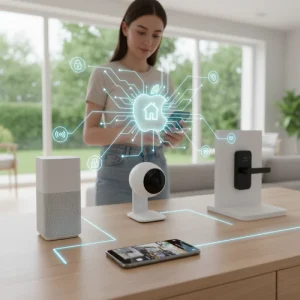 Apple HomeKit security offers a streamlined, privacy-focused approach to protecting your home. While the ecosystem may have fewer device options compared to other platforms, the trade-off is worth it for users who prioritize strong encryption, seamless integration, and reliable automation. From cameras and doorbells to sensors and locks, the HomeKit platform provides the tools to build a system that matches your lifestyle. Whether you’re safeguarding a single apartment or a larger home, the combination of Apple’s ecosystem and carefully chosen gadgets ensures your property remains both smart and secure.
Apple HomeKit security offers a streamlined, privacy-focused approach to protecting your home. While the ecosystem may have fewer device options compared to other platforms, the trade-off is worth it for users who prioritize strong encryption, seamless integration, and reliable automation. From cameras and doorbells to sensors and locks, the HomeKit platform provides the tools to build a system that matches your lifestyle. Whether you’re safeguarding a single apartment or a larger home, the combination of Apple’s ecosystem and carefully chosen gadgets ensures your property remains both smart and secure.
Your home deserves more than a “safety” sign in the yard or a fake camera stuck to the wall. With Apple HomeKit, you get a system that’s private, practical, and powerful — a modern solution for modern living.
